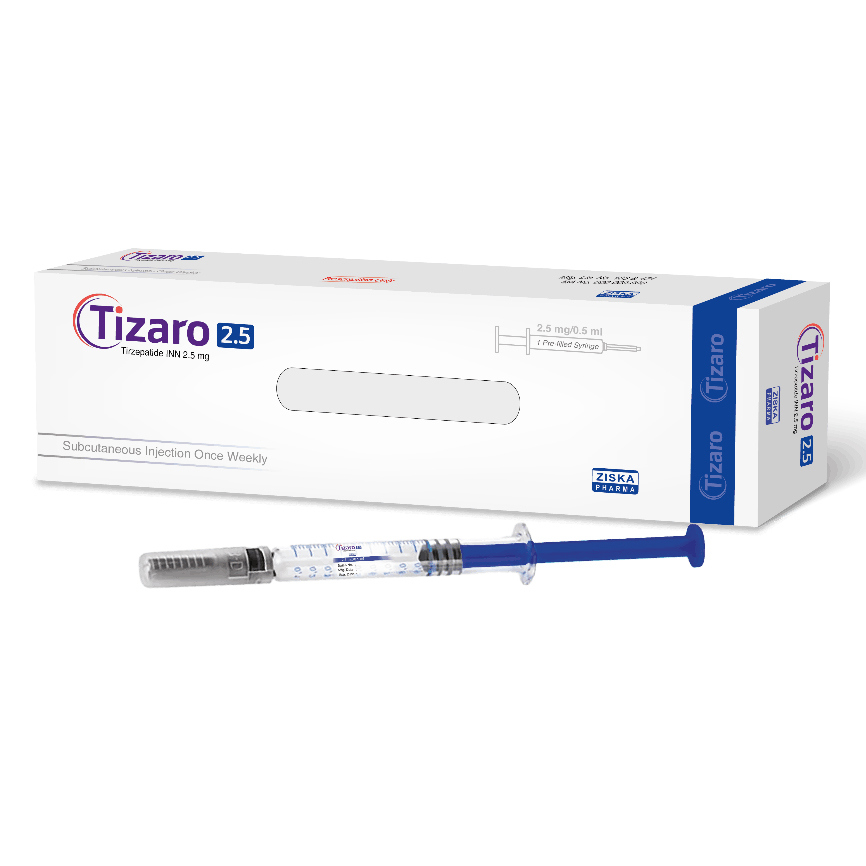2.5 mg pre-filled syringe:
৳ 1,200.00
Also available as:
Indications
Tizaro is indicated as an adjunct to diet and exercise to improve glycemic control in adults with type 2 diabetes mellitus.
Limitations of use:
Limitations of use:
- It has not been studied in patients with a history of pancreatitis.
- It is not indicated for use in patients with type 1 diabetes mellitus.
Pharmacology
Tirzepatide is a GIP receptor and GLP-1 receptor agonist. It is a 39-amino-acid modified peptide with a C20 fatty diacid moiety that enables albumin binding and prolongs the half-life. It selectively binds to and activates both the GIP and GLP-1 receptors, the targets for native GIP and GLP-1. It enhances first and second-phase insulin secretion and reduces glucagon levels, both in a glucose dependent manner.
Dosage & Administration
Route of administration: Tirzepatide should be administered as a subcutaneous injection.
Dosing instructions-
Dosing instructions-
- The recommended starting dosage is 2.5 mg injected subcutaneously once weekly. The 2.5 mg dosage is for treatment initiation and is not intended for glycemic control.
- After 4 weeks, increase the dosage to 5 mg once weekly. If additional glycemic control is needed, increase the dosage in 2.5 mg increments after at least 4 weeks on the current dose. The maximum dosage is 15 mg injected subcutaneously once weekly.
- If a dose is missed, instruct patients to administer it as soon as possible within 4 days (96 hours) after the missed dose. If more than 4 days have passed, skip the missed dose and administer the next dose on the regularly scheduled day. In each case, patients can then resume their regular once weekly dosing schedule.
- The day of weekly administration can be changed, if necessary, as long as the time between the two doses is at least 3 days (72 hours).
- The needle cover of the pre-filled syringe contains dry natural rubber (a derivative of latex), which may cause allergic reactions.
- Do not freeze. Do not use Tirzepatide that has been frozen.
- Protect pre-filled syringes from light.
- Parenteral drug products should be inspected visually for particulate matter and discoloration prior to administration. Do not use any pre-filled syringes exhibiting particulate matter and discoloration.
- Handle it carefully. If the pre-filled syringe dropped on a hard surface, do not use it.
- Do not dilute Tirzepatide and do not administer in conjunction with other drug solutions.
- Administer once weekly, any time of day, with or without meals.
- Inject it subcutaneously in the abdomen, thigh or upper arm. Rotate injection sites with each dose. When using with insulin, administer as separate injections and never mix. It is acceptable to inject Tirzepatide and insulin in the same body region, but the injections should not be adjacent to each other.
Interaction
Drug interaction with medication: Consider reducing the dose of concomitantly administered insulin secretagogues (e.g., sulfonylureas) or insulin to reduce the risk of hypoglycemia. Tizaro delays gastric emptying and thereby has the potential to impact the absorption of concomitantly administered oral medications. Monitor patients on oral medications dependent on threshold concentrations for efficacy and those with a narrow therapeutic index (e.g., warfarin) when concomitantly administered. Advise patients using oral hormonal contraceptives to switch to a non-oral contraceptive method or add a barrier method of contraception for 4 weeks after initiation and for 4 weeks after each dose escalation with it. Hormonal contraceptives that are not administered orally should not be affected.
Contraindications
Tirzepatide is contraindicated in patients with known hypersensitivity to tirzepatide or any other components of this product. It is also contraindicated in patients with a personal or family history of medullary thyroid carcinoma (MTC) or in patients with multiple endocrine neoplasia syndrome type 2 (MEN 2).
Side Effects
The most common side effects are nausea, diarrhea, decreased appetite, vomiting, constipation, dyspepsia and abdominal pain.
Pregnancy & Lactation
There are risks to the mother and fetus associated with poorly controlled diabetes in pregnancy. Tirzepatide should be used during pregnancy only if the potential benefit justifies the potential risk to the fetus. The developmental and health benefits of breastfeeding should be considered along with the mother’s clinical need for tirzepatide and any potential adverse effects on the breastfed infant from tirzepatide or from the underlying maternal condition.
Precautions & Warnings
Counsel patients regarding the potential risk for MTC with the use of Tizaro and inform them of symptoms of thyroid tumors. After initiation, observe patients carefully for signs and symptoms of pancreatitis. If pancreatitis is suspected, discontinue Tizaro and initiate appropriate management. The risk of hypoglycemia may be lowered by a reduction in the dose of sulfonylurea (or other concomitantly administered insulin secretagogue) or insulin. If hypersensitivity reactions occur, discontinue use of Tizaro; treat promptly per standard of care and monitor until signs and symptoms resolve. Monitor renal function when initiating or escalating doses in patients with renal impairment reporting severe gastrointestinal adverse reactions. Patients with a history of diabetic retinopathy should be monitored for progression of diabetic retinopathy. If cholelithiasis is suspected, gallbladder diagnostic studies and appropriate clinical follow-up are indicated.
Use in Special Populations
Use in children and adolescents: Safety and effectiveness of Tizaro have not been established in patients under 18 years of age.
Overdose Effects
Appropriate supportive treatment should be initiated according to the patient’s clinical signs and symptoms. A period of observation and treatment for these symptoms may be necessary, taking into account the half-life of Tizaro is approximately 5 days.
Therapeutic Class
GLP-1 receptor agonists
Storage Conditions
Keep out of the reach and sight of children. Store in a refrigerator at 2°C to 8°C. Do not freeze and protect from light. Do not use if it has been frozen. To be taken and sold only on the prescription of a registered physician.


